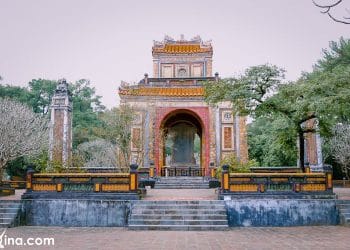Hue attracts tourists by royal tombs, temples, pagodas with tremendous and magnificent architecture. Diên Thọ palace is no exception. Visiting Dien Tho palace, tourists feel excited to discover one more work of art of the imperial city.
Location:
Diên Thọ palace is located in the western of the Forbidden City, the southern of Phung Tien temple and the north of Truong Sanh palace. According to the principles of Tu Duc Kinh, the palace lies on the Tay Nhat precinct of the imperial city, near Chuong Duc gate and Tay Khuyet tower.
History And Meaning Of Dien Tho Palace:
Dien Tho palace, which was initially called Truong Tho palace, was built in 1803. The palace was aimed at accommodations and daily routines of the Empress Mother. After that, the palace has changed the name four times: Tu Tho, Gia Tho, Ninh Tho and Dien Tho. The structure had a little change, but the function was kept in the same, which means the private apartment of Empress Mothers (even for Grand Empress Mother) in the Nguyen Dynasty. Its name has still kept the meaning with the purpose of “lengthening the life expectancy and life”.
Architecture:

Compared to other areas in the imperial city, Dien Tho palace had a considerably large scale. The plane of the total area is a rectangle (126,4 x 138,5m) with the area of 17.500m2, which account for 1/20 the total square area of the Imperial City, Forbidden City ((360.000m2). The palace has an upper two-meter-high wall circle; four directions are towards four gates. Among them, the most crucial gate is Tho Chi, the main entrance is on the southern side, and the gate is in the northern; also it has the lobby across the Forbidden City. The main direction of Dien Tho palace is the northwestern- southeastern – the common direction of Hue imperial citadel.
In the palace, there are about 20 small and large architectures. These architectures have a variety of figures (temple, tower, floor, pavilion), and they are also an example of the architectural style because they were constructed in different periods of history. Hence, Dien Tho palace is considered the typical union of architectures in the Nguyen Dynasty.
The primary architecture of Dien Tho palace is the main temple. It is a double house in “trùng thiềm điệp ốc” style (a traditional architecture of Vietnam) with the area of 960m2. The central temple consists of seven compartments and two lean-tos, the front temple has five bays and two lean-tos, which are interconnected by the crab-shell-shaped truss in meticulous carving. Behind the central temple is Tho Ninh palace for the second Empress Mother. In the past, the architecture of the temple was significantly large, including seven compartments; then it was narrowed down to three bays and two lean-tos. The lobby conjoined Tho Ninh palace and the main temple.
The eastern of the temple was Truong Du pavilion, a lovely wooden architecture situated on a rectangle lake with the area of 530m2. This pavilion was constructed in 1849 and used to serve the leisure time of Empress Mothers. In the southern side, Truong Du pavilion was connected with a small temple –Luong Phong. From Luong Phong temple, there was a bridge to connect with two rockeries in the middle of the lake. A lobby was built to link Truong Du pavilion to the main temple.

The northwestern part of the main temple was Phuoc Tho hermitage (so-called Khuong Ninh house). This was the two-storey house and built in 1831 to serve the Empress Mothers’ worshipping to goddesses and Buddhists. The upper floor had five compartments which were used to place Buddhist statues, Gods and shrines. Besides five main compartments, the lower floor had an outbuilding system surrounding four sides. The hermitage is toward the southwestern, and opposite to rockeries.
The southwestern of the main temple was initially Thong Minh Duong, a particular court theater for the Empress Mother. In 1927, a new two-storey house was constructed to alter Thong Minh Duong. Until 1950, this new house was restored largely for the temporary accommodation of the puppet head of state Bao Dai.
Opposite to Tinh Minh Lau is Ta Tra, where guests were waiting when they came to Dien Tho palace to visit the Empress Mother.
In front of the main temple was a large brick screen. In the eastern of the screen, a lobby was connected with Forbidden City to make it convenient for the king to inquire after the Empress Mother’s health. The lobby system in Dien Tho had the tile-roofing lean-to interconnecting all of the main architectures of the palace. Hence, the lobby system not only created the sustainable union of the monument complex but also brought softness of the entire structure in the palace.
It will be incomplete if you forget to visit the architecture of Dien Tho palace – unique work of art in Hue imperial city. This place promises to bring a great experience for tourists who are keen on discovering the cultural values and architectural layouts of ancient monuments.
By Minh Phuong















